Palermo: Things to do in a bustling city
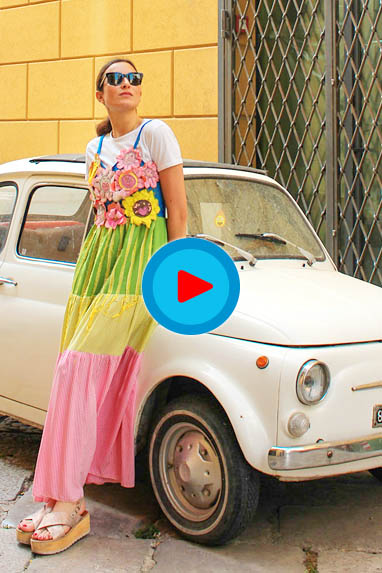
Unfortunately, too many holiday-makers to Sicily come away disappointed by Palermo. This is understandable: Palermo can play tricks on the unprepared! These four insider tips will help you out:
- Winter: Sicily is so roasting hot in summer that even the breeze is hot. Who wants to go sightseeing inside a giant tumble dryer? Add in the crowds and traffic of Palermo, and you may reach the point where yet another delicious ice-cream just can't help. It's better to spend your summer holidays renting one of Sicily's beautiful cottages by the sea, and visit Palermo in winter instead: you'll have the place almost to yourself.
- Side-streets: The side streets of Palermo are perfectly safe – indeed, Palermo is one of Italy's safest cities for tourists – but they are medieval and narrow and it is incredibly easy to get lost in them! Unless your orientation skills are superb, stick with the larger roads.
- Information: Nothing is self-explanatory in Palermo. There is a fascinating and often astounding story behind every attraction, but you will not find a plaque on the wall telling you about it. You can unearth the secret history of Palermo on this website.
- Food breaks: The eateries near tourist attractions charge rip-off prices all over the world. Palermo is no different. The food is always good but, if you head away from the crowds of tourists, you'll get mouthwatering food and drinks for far less. Check out some reviews below.
If you follow our four tips, you can experience one of Europe’s most extraordinary cities without hassle. We have three chapters on things to do in Palermo:
Author
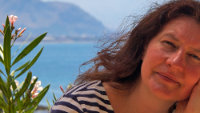
The information on this site comes from our Sicily expert Britta Bohn.
Britta has been dealing with daily life and life in Sicily for over 20 years.
Don't miss any of her tips! Subscribe to our free Newsletter:
An Invitation
Dear friends of Sicily, we invite you to join the Facebook Group "Trip-Tipp Sicily". Find answers to all your questions and discover exclusive tips for your trip to Sicily from those who have already made the journey and those who already know the island from the inside out:
Content
- Chapter I: Getting to Palermo
- Chapter II: Short Sightseeing Tour of Palermo (for a first impression)
- Chapter III: Sightseeing and Attractions in Palermo (recommended for a second or longer visit)
- Find your ideal holiday letting
Holidays lettings in Sicily
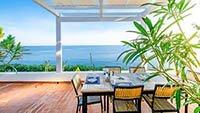
Are you looking for holiday lettings in Sicily but can't see the wood for the trees? We're not surprised, because the range of choices competing online is pretty confusing.
To make it simple, we present a small selection of quality holiday rentals, each one chosen for an unusual feature to make your holiday in Sicily extra special... more
Fashion made in Sicily
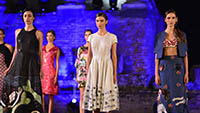
Sicilian fashion? Dolce & Gabbana?
Sure! But fashion designed and manufactured in Sicily is the real insider tip.
Like that of the Sicilian designer Filly Cusenza from Bagheria. She creates wearable art made of fabric, thread and buttons. Her trademark and label name is the fancy cartoon girl Filly Biz... more
The Essence of Sicily

Chapter I: Getting to Palermo
If you base yourself outside Palermo for your holiday, you have three options for travelling in to Palermo for sightseeing:
To Palermo by car
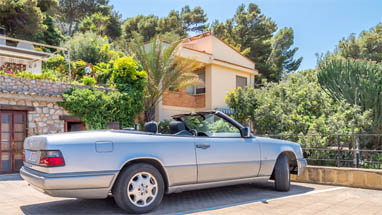
If you want to visit Palermo by car, you should be warned about the slightly "eccentric" driving style of many Sicilians. It is less dangerous than often claimed, but it can be hair-raising for newbies. If you are not a very confident driver, you may want to look at the next section on Trenitalia instead!
For those who are experienced at driving in Sicily, Palermo is not a problem. On Map I, the blue markers 2 to 5 show some centrally-located parking.
You can almost always find a spot here, since you have to pay. Compared to the price of the rental car and petrol, the parking fees are negligible.
To Palermo by Trenitalia
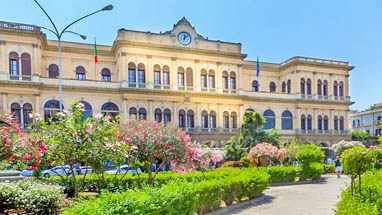
The relaxing way to spend holidays travelling around Sicily is by rail, using Trenitalia (blue marker 1 on Map I and red marker 6 on Map II).
This is especially true if you stay in some of the holiday lettings described on this website. They are in the Palermo area and close to local railway stations. If you stay in these places, Trenitalia is not only stress-free, but also faster than using a car.
Palermo central railway station (pictured right) is a major hub for travel all over Sicily, by bus, coach and train. The coach station provides fast and frequent connections to all three airports.
To Palermo by coach

Palermo is a central hub for inter-city coaches, which stop at the coach station adjacent to the railway station. This gives you plenty of options for travelling to Palermo by coach or bus.
Coach travel is very economical and convenient if you are staying near a coach stop. Sicily has various private providers, so there is no unified timetable. Some of the main providers and most useful lines are:
- from Messina Station (Piazza della Repubblica) with SAIS autolinee
- from Catania Station (Via D'Amico) with SAIS autolinee
- Enna (Viale Armando Diaz) with SAIS autolinee SAIS autolinee
- Agrigento (Piazzale Rosselli) with Cuffaro
- from Marsala station (Viale Amerigo Fazio) with Salemi
- from Trapani Station (Piazza Umberto) with Interbus/Segesta
To Palermo by cruise ship
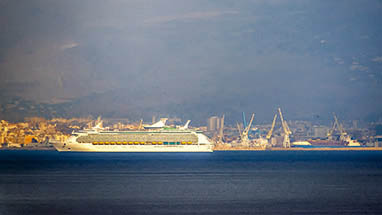
Palermo is one of the few Sicilian cities whose attractions can be reached not only by car, bus and train, but also on board a cruise ship. The ships stop in the city's harbour, which is walking distance from many of Palermo’s major tourist sights.
At first glance, it seems most logical to exit the harbour at the main port (blue marker 6 on Map I) and take the broad Via Emerico Amari to the city centre. Instead, we recommend the "secret path" marked in green.
Not only is it much quieter, but it also leads you to the greenest and loveliest pedestrian zone in Palermo, Via Principe di Belmonte. This is the perfect starting point for our Short Sightseeing Tour of Palermo.
If you leave your cruise ship and want to take a city sightseeing bus, you just need to go a few hundred metres. Bus stop B7, directly opposite the main gate of the harbour, is the sightseeing bus departure point. For more information on sightseeing in Palermo, see Chapter III.
Chapter II: Short Sightseeing Tour of Palermo
Palermo is a sprawling city, so we recommend the best things to do, only seeing some selected sites for your first visit. They are quite close together, and there are plenty of good places to eat along the way. After this, to explore further afield, we recommend a sightseeing bus tour (Chapter III).
Map I:
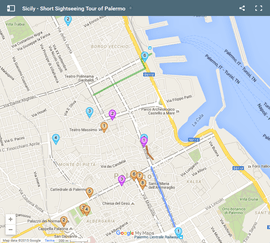
- Via Roma - Shopping
- Mercato Vucciria
- "Slow walk" from the port to the city
- Main station
- Parking Giardino Inglese
- Parking Piazza Ungheria
- Underground car park Piazza Vittorio Emanuele Orlando
- Underground car park under the department store La Rinascente
- Main gate to the port
- Bar Obikà in the department store La Rinascente
- Feltrinelli - bookshop and bar
- Palazzo Riso
- Teatro Massimo
- Palazzo Die Normanni (The Norman Palace)
- Villa Bonanno
- Casa Romana
- Cathedral
- Quattro Canti Crossroads
- Fontana Pretoria
- Chiesa di San Cataldo
Via Roma
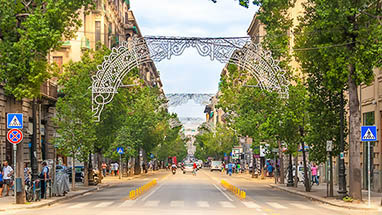 Pin it
Pin it When you leave Palermo Central Station and cross the large forecourt, you will reach Via Roma, Palermo's most famous shopping street.
The most interesting section of Via Roma is shown by a blue line on Map I. The street mainly features clothing and accessory shops, offering classic Italian fashion displayed with typical style and flair.
The middle section of Via Roma passes through the old town. It is wide, airy and even has some green leafy borders, which makes it a pleasant starting point to delve into the intriguing and secretive heart of old Palermo. This can be one of the most interesting things to do in Palermo, as you are likely to see characters and street scenes which do not exist anywhere else in the world.
The road to and from all the attractions we describe cuts across Via Roma. If you want to bring back souvenirs from your Sicilian holiday, you would do best to buy them on your way back to the Central Station.
- TripAdvisor reviews of Via Roma.
Vucciria street market
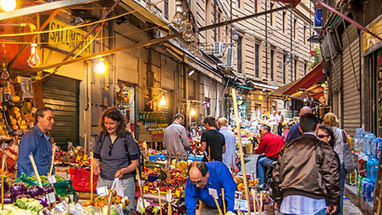 Pin it
Pin it The Vucciria (pronounced "vucchi-rEEa") is one of Palermo's oldest markets, founded hundreds of years ago. For centuries it was a bustling mass of Sicilians frenetically buying their unusual groceries, and truly an experience to walk along.
Many guide books still describe it as one of the mains things to do in Palermo, but this area is mainly populated by immigrants nowadays, who do their shopping elsewhere. The Vucciria is a mere shadow of its former noisy self, mainly filled with tour guides and groups of subdued tourists, who tend to go away disappointed.
Palermo gets minus points from many people because of this. But if you are interested now, you can have a quick look into the Vucciria as you tour Palermo. As Map I shows (brown line), it runs directly from Via Roma.
- TripAdvisor reviews of the Mercato Vucciria.
Break - Bar Obikà
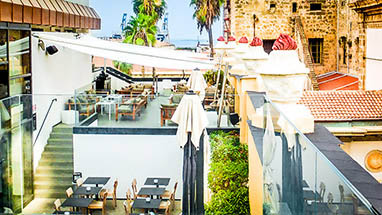 Pin it
Pin it Directly opposite the Vucciria market, on the other side of Piazza San Domenico, stands La Rinascente department store. On its rooftop you can take a break in the stylish "Bar Obikà" (purple marker 1 on Map I and brown marker 4 on Map II).
You can spread out and relax on the open-air sofas here, order a snack or a meal from the English-speaking waiters, and wander around to enjoy and photograph the views in every direction. You will see out over the city of Palermo on one side and the port and sea on the other. You will also get unique, close-up views of the high statues that adorn the facade of the church, the Chiesa San Domenico, and the statue of the Madonna which stands on a high column overlooking the square.
If there ever was a "must see" in Palermo, this is it!
- TripAdvisor reviews of Bar Obikà.
Contemplative Palermo - Teatro Massimo
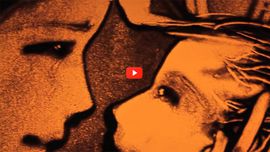
Teatro Massimo
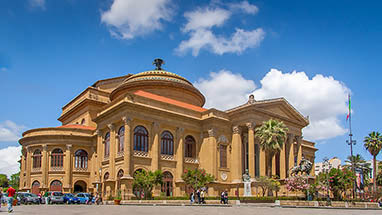 Pin it
Pin it The Teatro Massimo is a major attraction for any visitor to Sicily (brown marker 1 on Map I). It is one of the symbols of the old glory-days of Palermo, its subsequent decline and finally rebirth.
The Teatro Massimo was designed at the end of the 19th Century by the famous Sicilian architects Giovanni Battista Filippo and Ernesto Basile.
At that time Sicily had become fabulously wealthy by exporting citrus fruits, the newly discovered cure for scurvy which saved the sailors of Europe on long trips; Marsala, a sweet Sicilian fortified wine developed by English aristocrats in Sicily and praised to the skies by Lord Nelson; and sulphur, which was mined in central Sicily and dominated the world's market at that time.
Awash with cash, Sicily decided to build the largest opera house in Italy and call it "the greatest theatre". The opera house was a triumph, a truly beautiful and spectacular building. It still has the second largest stage in Europe and is Europe's third largest theatre.The accoustics are outstanding.
After this brief period in which Sicily flourished, the island was dragged down by an elite class which consisted of an out-of-touch aristocracy, an ultra-conservative church hierarchy, and the increasingly powerful Mafia. They threw Sicily into a mire of economic depression and inward-looking regression.
As one of the many consequences, the Teatro Massimo had to be closed down in 1974, in a state of dangerous disrepair. It is not surprising that the first anti-Mafia mayor of Palermo, Leoluca Orlando, organised the restoration of the Teatro Massimo as an important symbol of the rebirth of Palermo. He re-opened the restored Opera House in 1997.
The interior of the theatre is, like its exterior, so magnificant that daytime tours are offered for those who wish to see inside without actually attending an evening of opera.
- Opening times and admission prices to the Teatro Massimo.
- TripAdvisor reviews of the Teatro Massimo.
Break - Feltrinelli
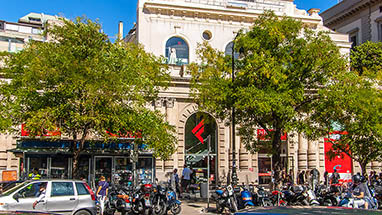 Pin it
Pin it Very near the Teatro Massimo, you will find Feltrinelli the book shop (purple marker 2 on Map I and brown marker 3 on Map II). Feltrinelli was founded in the post-war period as a publisher, but now operates book shops as well.
The branch in Palermo is fairly new and is home to a small bar that provides a perfect retreat from the crowds of tourists around the Teatro Massimo. Although you will find yourself among locals rather than tourists, there are always plenty of people in Feltrinelli who speak English.
It was Feltrinelli which published the works of Giuseppe Tomasi di Lampedusa, who was born in Palermo, Sicily and was author of the legendary novel The Leopard.
Palace of the Normans (Palazzo Reale) • Villa Bonanno • Casa Romana
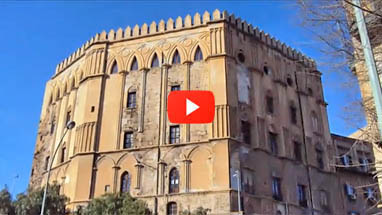
Until 1061, Sicily was an Arab colony. Pope Alexander II was not happy about this.
He declared that Sicily was actually his, since the whole of Western Europe had been given to the Pope as a gift by the Emperor Constantine, and he had a scroll to prove it. This so-called Donation of Constantine must surely be the greatest forgery in European history.
Intent on making Sicily his, Pope Alexander hired Norman mercenaries. They lived in the undergrowth like bandits for ten years, but eventually conquered the island. They ruled Sicily as a fiefdom – on loan, so to speak – and one of their leaders was appointed King Roger I of Sicily.
Roger took over one of the Arab palaces, enlarged it and used it for administration. It is nowadays known as The Palace of the Normans (brown marker 2 on Map I and brown marker 13 on Map II).
The Normans' power had already waned by 1194 and the palace frequently changed ownership. Random additions were made in a patchwork of styles which make the outside of the building a perfect lesson in the history of architectural styles, though rather hair-raising for architectural purists. The loss of some of the facade in earthquakes adds to the staggeringly messy effect.
Even so, it is the vast range of periods and styles to be seen inside the Palazzo Dei Normanni which make it possibly the most fascinating royal Palace in Europe. Its chapel, the Capella Palatina, is lined throughout with Byzantine mosaics outlined in pure gold, and ranks as one of the world's most beautiful religious buildings. Visiting the Palazzo Dei Normanni is indisputably one of the most fascinating and pleasurable things to do in Palermo.
After visiting the palace you can relax in the Villa Bonanno, a small park to the east of the Norman Palace (brown marker 3 on Map I). Among the palm trees are some ancient Roman remains, (brown marker 4 on Map I) some of the surprisingly few which survive from the Roman period in Palermo.
- Opening times and admission prices to the Norman Palace (managed by the "Fondazione Federico II").
- TripAdvisor reviews of the Norman Palace.
Above the Rooftops of Palermo
How to virtually enjoy the view from the roof of Palermo Cathedral:
- click or tap the green circle in the middle of the image to start the tour
- drag your finger or mouse left, right, up or down to change the camera angle; you can also use the arrow keys on your keyboard
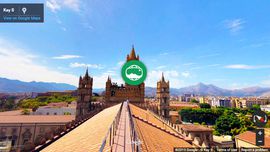
Palermo Cathedral
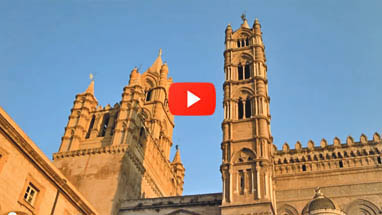
The Normans completely rebuilt Palermo Cathedral, symbolically reclaiming Sicily for the Pope spiritually as well as physically (brown marker 5 on Map I and brown marker 12 on Map II).
In Sicily, of course, nothing is as black and white as it seems. If you look carefully at the Cathedral, you will spot a passage of the Koran carved into a stone plaque on the outside wall. There are elements of Arab architectural design throughout the cathedral.
In reality, the Normans in Sicily were not crusaders celebrating the destruction of Arab culture. In fact, they adopted it wholeheartedly. They took to wearing Arab clothes, eating Arab food and keeping their women in harems. They built Arab style buildings wherever they could. The Normans in Sicily were renowned for their religious and racial tolerance, and it was under their rule that Jews, Muslims and Christians lived side by side peacefully in Palermo and the surrounding areas. Palermo Cathedral bears testament to this exemplary regime, with cultural diversity carved into its very walls.
The Sicilian well understand this part of their own history, speaking of the "Arab-Norman period" as an era of great prosperity.
Surprisingly, this period in Sicilian history also includes a brief period during which Swabians from Germany ruled the island. In 1194 the Normans were followed by the Swabian (Staufer) Dynasty. The most famous ruler of this dynasty was the Frederick II, who based himself in Sicily.
Frederick was crowned king of Sicily when he was three. He was a man born long before his time, for whilst the Spanish and much of Europe were in the depths of the Inquisition, Frederick II insistently placed "knowledge" before "faith" in all things. Whilst dictatorial, he might be referred to as an enlightened despot.
An avid patron of science and the arts, he oversaw the first use of the Sicilian language in its literary form. The Sicilian poetry produced by his court was admired by Dante Alighieri, among others, and heavily influenced Italian literature and the modern Italian language.
Frederick's sarcophagus can still be seen in Palermo Cathedral.
- Opening times and admission prices to the cathedral: the site is in Italian, but click on the link "orari e modalità di visita" on the left to see opening times.
- TripAdvisor reviews of the cathedral.
Break - Palazzo Riso
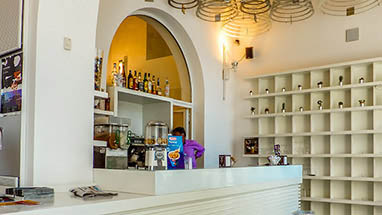 Pin it
Pin it Very close to the Fontana Pretoria lies the Modern Art Museum, the Museo d'Arte Contemporanea (purple marker 3 on Map I and brown marker 11 on Map II). It hosts a small bar with large windows overlooking the street. You can relax in this peaceful haven while watching the hustle and bustle in Piazza Bologni.
The museum and bar are housed in the historic Palazzo Riso. In the middle of the 19th Century it was a regular meeting place for a small but dedicated group of democratically-minded aristocrats. Unfortunately they were an exception to the prevailling attitude among those with power in Palermo.
- TripAdvisor reviews of the museum at Palazzo Riso.
Fontana Pretoria • Quattro Canti • Chiesa di San Cataldo
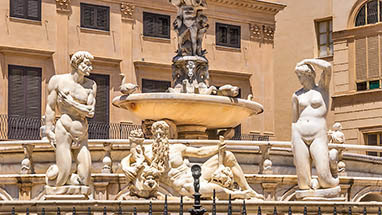 Pin it
Pin it The Fontana Pretoria (brown marker 7 on Map I) was Palermo's most controversial monument when it was first unveiled 400 years ago. The square where it stands was immediately dubbed "The Piazza of Shame" (Piazza della Vergogna) and it is still called that by most people in Palermo.
The numerous statues all over the fountain offended on all fronts. Firstly, they depicted pagan gods such as Bacchus, the god of drunken orgies, rather than suitably Christian subjects. Secondly, they were all stark naked. Not only this, but they were cavorting around lasciviously and touching each other. Since the fountain stands directly outside Palermo’s Town hall, the moral corruption portrayed in the fountain could be seen as symbolic.
Nowadays the Town Hall has been cleaned up a great deal by the first anti-Mafia mayor of Palermo, Leoluca Orlando. As for the fountain, we have been de-sensitised by the likes of Miley Cyrus these days so it is unlikely even to raise an eyebrow.
The Fontana Pretoria looks different from every angle and can be very inspiring for keen photographers. Winter is the ideal time to snap pictures without anyone walking in the background.
Two other very famous sights lie within a stone's throw of Piazza Pretoria. At the Quattro Canti crossroads, two of Palermo's most important streets intersect (brown marker 6 Map I and brown marker 10 on Map II). The four buildings facing each other at the crossroads are embellished with four fountains which once supplied drinking water, magnificent statues personifying the four seasons, and statues of the four former patron saints of Palermo. These saints are now redundant since they failed to protect the city from the plague. They were replaced by Saint Rosalia, who succeeded and has been the adored patron saint of Palermo ever since. This junction is an example of the Baroque architecture and town planning typical during the Spanish occupation.
The Chiesa di San Cataldo (brown marker 8 on Map I) is several centuries older. It is easy to see it was once a mosque, dating back to the Arab period. An interesting thing to do in this part of Palermo is to look out for the street names. You will see that some of them are written in Arabic, Hebrew and Italian. Whilst the Arabic and Hebrew signs or essentially obsolete, they are treasured by the people of Palermo as a memento of a time when their city was more cosmopolitan and a paradigm of tolerance.
- TripAdvisor reviews of the Fontana Pretoria..
- TripAdvisor reviews of the Quattro Canti crossroads.
- TripAdvisor reviews of the Chiesa di San Cataldo.
Chapter III: Sightseeing and Attractions in Palermo
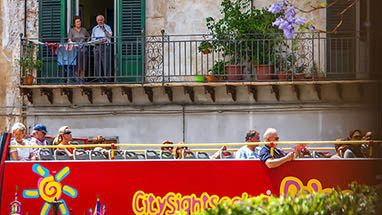 Pin it
Pin it For a more extensive sightseeing tour of Palermo, the ideal means of transport is the City Tour Bus. There are two bus routes designed for tourists, which follow two continuous loops that pass by all the important sights and things to do in Palermo.
You can either relax on board the bus and see the sights as you pass by, or get off at the sights that you are particularly interested in and resume your itinerary on the next city tour bus that passes. The sightseeing bus service calls this the "hop on - hop off" option.
The ticket is valid for 24 hours and you can mix both options within this period. You can start the tour at any of the 15 bus stops, so it is very simple and flexible.
The map below shows the two lines of the sightseeing buses and their 15 stops, reproduced from the company's brochure [PDF]. Please note that the historic center of Palermo is in a phase of relentless renovation and the positions of the stops are prone to change at any time without notice.
The prices and the timetable are available on the operator's website. NB: Please check the opening times of all the monuments and museums you plan to visit on their websites listed here, as in Italy these are always prone to last minute changes. (Please see the descriptions of the respective attractions.)
The bus stops are named after nearby attractions. Where the stop and the entrance to the attraction are not directly facing each other, we have indicated this using a brown marker. Other interesting sights nearby are also marked.
Some of the attractions have already been described in our "Short Sightseeing Tour of Palermo" (Chapter II). The other sights are described below.
Map II:
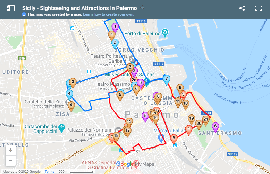
Linea A - Bus stops:
- Teatro Politeama
- Teatro Massimo
- Palazzo Steri
- Orto Botanico
- Stazione Centrale
- Quattro Canti
- Palazzo Reale
- Cattedrale
Linea B - Bus stops:
- Teatro Politeama
- Giardino Inglese
- Villa Malfitano
- Castello della Zisa
- Mercato del Capo
- Teatro Massimo
- Porto
Breaks:
- Bar Giardino Inglese
- Bars in Via Principe di Belmonte
- Bar and bookstore Feltrinelli
- Bar Obikà in the department store La Rinascente
- Bar Palazzo Riso
- Bar Villa Giulia
Things to see:
- Entrance Giardino Inglese
- Teatro Politeama
- Entrance Villa Malfitano
- Castello della Zisa
- Entrance Mercato del Capo
- Teatro Massimo
- Entrance Mercato Vucciria
- Chiesa San Domenico
- Marina 'La Cala'
- Entrance Palazzo Steri
- Entrance Villa Garibaldi
- Quattro Canti Crossroads
- Fontana Pretoria
- Chiesa San Cataldo
- Entrance Cathedral
- Villa Bonanno
- Casa Romana
- Palazzo Reale
- Chiesa Santa Maria dello Spasimo
- Orto Botanico
- Villa Giulia
Teatro Politeama
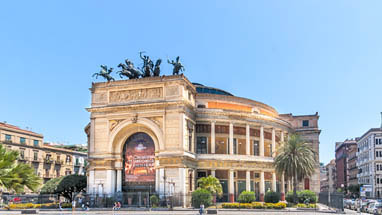 Pin it
Pin it To see why the bus stop has this name, click "satellite" on Map II, and zoom in on purple marker 1. You will see a large piazza and, to the right, a roof that looks like the front of the Starship Enterprise. This is the Teatro Politeama, after which the bus stop is named.
The circular Politeama theatre is highly decorated, with four magnificent statues of horses above the entrance. It was originally intended as an open air theatre, and indeed the first performance in it was held before the roof was put on.
The large open area to the east of the theatre is officially called "Piazza Ruggiero Settimo", and to the west "Piazza Castelnuovo", but the people of Palermo often refer to the whole area as Piazza Politeama.
The light and large open space of Piazza Politeama contrasts strikingly with the narrow streets of the old town. Palermo is a city whose streets and buildings were constructed over a period spanning more than a thousand years, and this type of contrast is an example of the variety resulting from this.
The Via Della Liberta leads from Piazza Politeama. One of the smaller sights in the piazza is an Art Nouveau newspaper stand - the "Chiosco Ribaudo" – identical to the one in front of the Teatro Massimo. These beautiful newspaper stands were designed by the architect who created the Teatro Massimo, Ernesto Basile.
The ornamental metal work on the kiosks was produced by the Fonderia Oretea, a foundry opened by Sicilian entrepreneur Vincenzo Florio. This same foundy created the metal roof of the Teatro Politeama, a work which was considered a ground-breaking feat of engineering at the time. The foundry was recently restored and is now a cultural center.
The Teatro Politeama is only open to visitors attending concerts.
Palazzo Steri • Villa Garibaldi
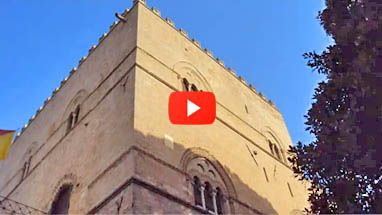
Palazzo Steri was built 700 years ago, and was originally called "Palazzo Chiaramonte" (brown marker 8 on Map II). The Chiaramonte family were powerful nobles who inspired a new style of architecture in medieval Sicily.
The Chiaramonte family's Norman roots can he seen in the style of the palace, which looks like a fortress. This is how it gained its modern name. Steri is an abbreviation of Hosterium Magnum, which means "fortified construction". There is a similar building in Cefalù, known as the Osterio Magno.
Palazzo Steri changed hands and usage many times over its 700 year history. Nowadays it is used by the University of Palermo, and also serves as a tourist attraction. Whilst it appeals to fans of medieval architecture, most tourists visit Palazzo Steri because of his "dark side". Palazzo Steri was used as the seat of the Spanish Inquisition in the C17th, where suspected heretics were interrogated, tortured and executed. You can visit some of the prison cells and see some of the prisoners' grafitti and startling paintings on the walls.
Those who want to relax in Sicily rather than be creeped out will find plenty of alternative things to do in this area! Villa Garibaldi park has vast fig trees (brown marker 7 on Map II) and Bar Casa Obatala (brown marker 9 on Map II) is a great place to relax. On Sundays there is a large flea market around Villa Garibaldi.
- Opening times and admission prices for Palazzo Chiaramonte Steri.
- TripAdvisor reviews of Palazzo Chiaramonte-Steri.
Orto Botanico • Villa Giulia
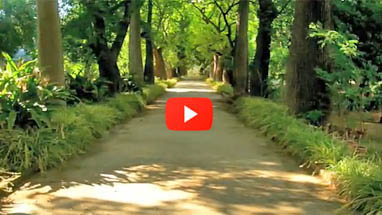
The park known as "Villa Giulia" was created in the C18th (brown marker 14 on Map II) and the botanical gardens, Orto Botanico, were founded in the same period (red markers in 5 Map II).
When they were first opened, the two parks were on the outskirts of the city, facing the sea (now the marina - brown marker 6 on Map II). Today, a wide street and a very long grassy public park called the Foro Italico Umberto I – always packed with Sicilian families on their days off - separates Villa Giulia from the sea.
Villa Giulia is a public park (check opening times) with formal gardens, an unusual sundial and the Fontana del Genio.
The sundial is in the centre of the gardens. It is a marble dodecahedron (that means it has twelve sides!) supported by a statue of Atlas, the Titan of Greek mythology who is usually depicted holding up the earth. The sun nearly always shines in Palermo, so this sundial can be used to tell the time accurately all year round.
The Fontana del Genio depicts the "Genius" of the city of Palermo. The word "Genius", to the ancient Romans, meant a guiding spirit, that little part of the great divine that exists in all people and also in other important entities. Every adult Roman had a small shrine to his own "genius" in his home, to which he made offerings to make sure he did not lose his direction in life or develop depression. The Romans also erected statues of the genius of a city, to which people could make religious offerings. Our meaning for the word genius, referring to people like Leonardo Da Vinci and Albert Einstein, derives from the fact that these people with exceptional vision seem to be guided by a powerful element of divine inspiration.
The genius of an individual was always depicted holding or near a serpent, symbol of male fertility and also health. The Genius of Palermo has, in addition, a crown, a sceptre and a bundle of rods to symbolise his power to rule and to impose justice and punishment where appropriate. He also has a cornucopia of fruit (the main source of Palermo's wealth when the statue was made), an eagle (still the symbol of the city of Palermo) and a dog by his feet (believed to be a symbol of renewal). There are about a dozen different depictions of the Genius of Palermo at other locations around the city.
The Orto Botanico (Botanical Garden) is affiliated to Palermo University and was originally dedicated to medicinal plants. Since its founding, many other specimens have been added, including rare species indigenous to Sicily. The botanical gardens are much larger than Villa Giulia and fascinating for botany lovers.
The entrance fee is very low.
- Opening times of Villa Giulia.
- Opening times and admission prices to the Orto Botanico.
- TripAdvisor reviews of Villa Giulia.
- TripAdvisor reviews of the Orto Botanico.
Trailer Drone - Monreale Cathedral

Duomo Monreale
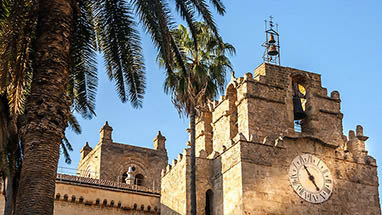 Pin it
Pin it Monreale Cathedral represents a stunning fusion of Arab, Byzantine and Norman architecture, and contains no less than 6,000 square metres of exquisite Byzantine mosaics. The mosaics of Monreale were made by expert mosaic makers brought in from Byzantium (now Istanbul), which was then the world centre of mosaic expertise.
They depict scenes and characters from the bible, all against a background of gold-plated tesserae. The reflections create spectacular lighting effects which change throughout the day.
The Cathedral of Monreale was founded by the Norman King William II, son of King William I of Sicily. They were contemporaries of the Norman King William I of England (William the Conqueror) and his son, King William II of England. Although separate family lines, these two Norman royal dynasties were closely connected through intermarriage and regular diplomatic and cultural communication.... not to mention their love of the name William!
If you look carefully inside Monreale Cathedral you will see a plaque commemorating Saint Thomas à Beckett. There is also a beautiful mosaic of him in them main apse, the first portrait of this Archbishop of Canterbury ever made in the world. The entire Cathedral of Marsala is also dedicated to him, for he was very much loved in Sicily.
How did his Sicilian connection begin? King Henry II tried to give secular courts jurisdiction over the clergy in England. Beckett objected strongly, and was forced to flee England. At first he went to France, but he had contacts in Sicily and in 1164 he ended up, with some friends and relatives also in exile, staying with King William II of Sicily.
After years of exile Becket returned to England, and was murdered in Canterbury Cathedral by four of King Henry's knights. When questioned they claimed that they were only following the king's request to be rid of a "meddlesome priest".
The Archbishop was canonised in 1173, and almost immediately his portrait was created in Monreale Cathedral and a new cathedral was dedicated to him in Marsala.
The Arab contribution to Monreale Cathedral is most obvious, especially in the decorations of the exterior walls and the inner collonade and garden. The Norman influence upon the defence towers is also hard to miss – another example of this Norman tendency to incorporate military features even in religious builings can be seen in Cefalù cathedral.
Monreale is located a few kilometres outside Palermo, but it is included in the itinerary of the sightseeing tour buses. You need to change bus at stop A7 (Palazzo Reale). The ticket is very cheap and Monreale really is not to be missed.
If you visit Palermo on a cruise ship and only have a few hours, check the timetable carefully. The trip to Monreale takes about a half an hour, and traffic jams can sometimes lengthen this time considerably.
There is an online virtual tour of the Cathedral of Monreale which shows how this cathedral deserves to be every bit as famous as the Sistine Chapel.
NB: The sightseeing bus to Monreale is only available from April to October.
- Opening times and admission prices to Monreale Cathedral.
- TripAdvisor reviews of Monreale Cathedral.
Relaxing - Giardino Inglese
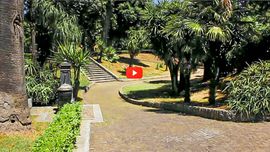
Break - Giardino Inglese
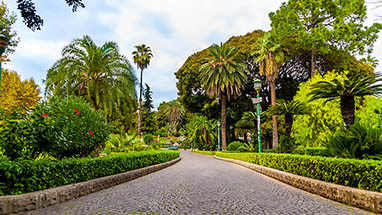 Pin it
Pin it Palermo's famous architect Ernesto Basile designed many of the attractions that make Palermo so beautiful, and among them is the Giardino Inglese, the so-called "English Garden" (brown marker 1 on Map II).
The garden was called "English" because it was designed as a landscaped garden with an informal, naturalistic structure. Many famous English gardens in this style were greatly admired by the Italians of the day, as they made a refreshing change from the Italian formal, geometric gardens which had not changed in design since the Renaissance. (Ironically, the formal style of garden had also been established throughout Italy by English gardeners several centuries earlier).
For Sicilians, the Giardino Inglese is a peaceful green haven in the centre of the city, full of things to do. It is a perfect playground for small children since it also contains a miniature theme park with paid rides, and a romantic rendezvous (with some good hiding places) for courting teenagers. To avoid the crowds, go on a week day.
The large bar in the Giardino Inglese offers a tasty range of refreshments and is part of the anti-Mafia Addiopizzo movement – another good reason to give it your support!
- Opening times of the Giardino Inglese.
- TripAdvisor reviews of the Giardino Inglese.
Villa Malfitano
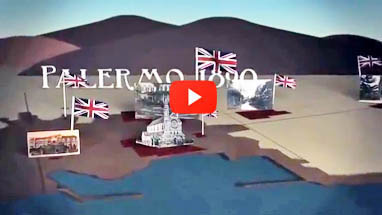
From the Giardino Inglese, we come to Villa Malfitano Whitaker (blue marker 3 on Map II). The park, and the palace within it, were built by Joseph Isaac Spadafora Whitaker. Half of the park is informal and "English" in style, whilst the other half follows the traditional Italian design.
The Whitaker family came from Yorkshire, England, and made their fortune in Sicilian wine. They invented Marsala wine, a sweet fortified wine still produced and exported worldwide today.
Although the video above shows only a few rooms of Villa Malfitano, it is abundantly clear that the Whitaker family was definitely not poor! The villa is packed with magnificent and precious objects, antique furniture and paintings which the Whitakers collected from far and wide.
His immense wealth gave Joseph Whitaker (nicknamed Pip) the opportunity to indulge in his hobbies, which included ornithology and archeology. No slacker, Joseph Whitaker discovered the Phoenician / Carthaginian origins of Mozia, an island which he bought for himself. He cataloged almost the entire bird population of Sicily. A keen sportsman, he founded Palermo football club. With his wife Catherine Joseph engaged in charitable works. They established a sailors' hostel, an orphanage and the Society for the Prevention of Cruelty to Animals.
The Whitaker dynasty flourished in Sicily until the 1920's, when they sold all their vineyards and wine cellars to Cinzano.
When Mussolioni came to power, he confiscated any property owned by British citizens. The Whitakers saved Villa Malfitano by writing it over to Sophia, one of Joseph Whitakers' two daughters, who had Italian citizenship. Her sister Cordelia died in 1971, the last "Sicilian Whitaker" of the Villa Malfitano. She bequeathed the villa and the island of Mozia to the "Giuseppe Whitaker" Foundation, thus opening it to the public.
Princes Under the Volcano - Two Hundred Years of a British Dynasty in Sicily by Raleigh Trevelyan tells the story of the Whitakers in Sicily.
- Opening times and admission prices to Villa Malfitano.
- TripAdvisor reviews of Villa Malfitano.
Castello della Zisa
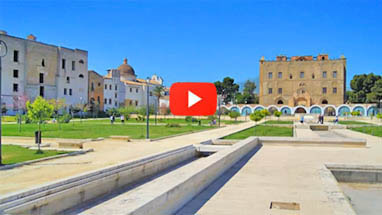
Most guide books build up great expectations of the Castello della Zisa (blue marker 4 on Map II), yet the reviews on TripAdvisor sound quite disillusioned.
This is understandable. Most monuments in Palermo are exquisitely ornate and have spectacular visual impact, whereas the Zisa, to the uninitiated, looks like nothing more than a very simple stone structure. Yet once you know how to imagine it in its glory days, it is unique and quite amazing
The Zisa was one of the hunting lodges that the Normans so loved to build for themselves, out in the countryside surrounded by forest. Even in these lush green surroundings the palace would have become very hot in summer, so its Arab architects devised an ingenious cooling system. The roof of the Zisa was a huge cistern for collecting rainwater. In the summer months, this water was passed through the walls and then fed into small fountains. The walls were cooled by the water, and the running water and fine mist in the fountains was even more refreshing. The sunlight was cleverly directed towards the fountains to make the droplets of water glitter and sparkle.
Sadly, all this is no longer in operation, but the remains of the channels, pools and fountains are still perfectly preserved. If you are interested in architecture and can use your imagination, the Zisa should definitely be included as a stop during your holidays in Palermo.
For those who can read Italian, the book La Zisa di Palermo by Giuseppe Bella Fiore gives an excellent account of the Zisa Palace.
- Opening times, admission prices and virtual tour of the Castello della Zisa.
- TripAdvisor reviews of the Castello della Zisa.
Mercato del Capo
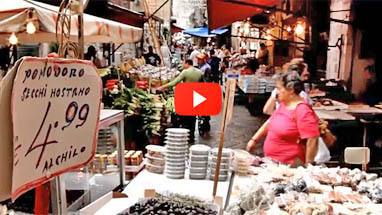
Unlike the Vucciria, the Capo is still a frenetically bustling street market throughout the day. It is open every day and used by many citizens of Palermo as their local supermarket (blue 5 marker on Map II).
It sells fresh fruit and vegetables very cheaply, and just about anything else you might need. The street vendors advertise the quality of the goods at the tops of their voices, usually in Sicilian, making a tour of the market most entertaining. Besides the crowds of people, vespas regularly make their way through the market delivering additional goods to the stallholders.
After the chaos of the market, you may need to calm down at a bar just around the corner in Piazza Vittorio Emanuele Orlando (brown marker 2 on Map II). The piazza is spacious, car-free and very quiet.
The bar looks out on the Palazzo di Justizia, the central law courts. This building is vast, and built in the very severe and imposing Italian Art Deco style known to Italians as "Fascist Architecture". This is where the fight against the Mafia in Sicily began in earnest in the 1970s - a battle which has achieved a great deal that once seemed impossible.
One of the great barriers that the anti-Mafia movement had to overcome was the mythology, invented by the Mafia themselves, that they were a kind of Robin Hood organisation that helped the poor and vulnerable. So successful were the Mafia spin-doctors that the population bought into these lies wholeheartedly.
The Mafia claimed that they originated as the Beati Paoli, a secret society supposed to have performed good works to help out the poor of Sicily, sometimes taking from the rich. There is no real proof that the Beati Paoli even existed, and if they did, they were certainly not the forerunners of the Mafia.
The supposed hiding places of the Beati Paoli include a network of underground tunnels and chambers snaking throughout the Capo market. There are interlinked caves, secret chambers leading from church crypts, catacombs, "camere dello scirocco" (underground rooms in which rich citizens sometimes took refuge from the intolerable heat of summer) and irrigation channels called Qanats built by the Arabs.
The Qanats carried water throughout the Palermo bay area and watered the citrus trees, brought to Sicily by the Arabs. Long after the Arabs had gone, these citrus fruits were sold to trading ships as scurvy treatment and made Palermo immensely wealthy. They filled the entire Palermo bay area, giving rise to its name the Conca D'Oro, the golden bay.
Trade in citrus fruits was Sicily's most successsful industry up until the 1980's, when the Mafia decided to take control of fruit sales by force, and intimidated all the citrus farm owners into selling their land. This gave them acces to all the entrances and exits of the Quanat network, which they have been known to use on more than one occasion to escape arrest when the police tracked them down to their homes. They would vanish under ground and emerge several miles away, in central Palermo. The Sicilian citrus fruit industry has been run into the ground after more than three centuries and is now no longer profitable at all.
- Guided tour through the qanat network: one of the most unusual things to do during your holidays in Palermo!
- TripAdvisor reviews of the Mercato del Capo.
Porto
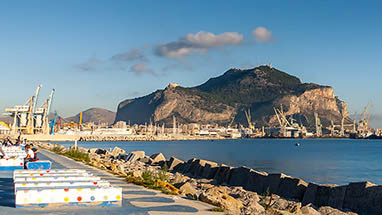 Pin it
Pin it On the map of Palermo it is immedietely striking that the city curves around the large harbour (brown marker 6 on Map II). The city gradually expanded around this busy focus of sea trade over centuries. It has now been turned into an attractive marina for yachts.
By clicking "satellite" on the top right of map II and zooming in on brown marker 6 you can see the marina very well. It was renovated a few years ago and today it is one of the gems of the city. As yet, the city tour buses do not stop here. Instead, they stop off at "bus stop B7: Porto", the port which is near the right hand side of Palermo harbour.
It is large enough for modern cruise ships, so it makes sense to position the bus stop opposite the main gate of the port. Cruise guests can therefore join the tour bus directly from their ships.
Visitors who prefer to explore the attractions of Palermo by themselves should follow our Short Sightseeing tour of Palermo in Chapter II instead.